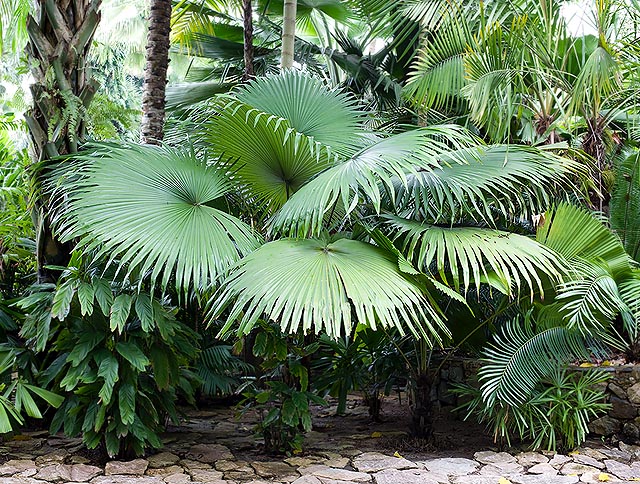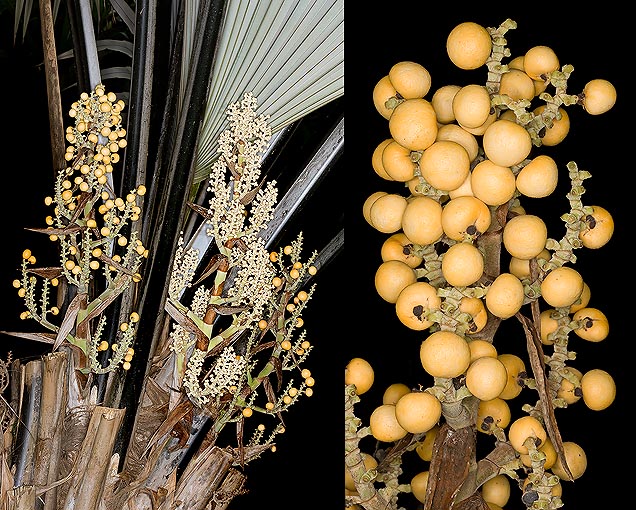Family : Arecaceae

Text © Pietro Puccio

English translation by Mario Beltramini

The splendid leaves of Kerriodoxa elegans are almost circular with 2 m of diametre © Giuseppe Mazza
The name of the genus is the combination of the name of the Irish botanist Arthur Francis George Kerr (1877-1942), scholar of the Thai flora, with the Greek word “doxa”, in this instance utilized with the meaning of “glory”; the name of the species is the Latin word “elegans” = elegant, genteel.
Common names: white elephant palm, king thai palm (English); chao-mueng-ta-lang, ching-lang-khao, thang-lang-khao (Thai).
The Kerriodoxa elegans J.Dransf. (1983) is a solitary plant, dioecious, inermis, acaulescent or with a stem tall up to 5 m and a diameter even of 20 cm, where are possibly visible the annular, close, scars of the junction of the fallen leaves, but usually covered by the decaying foliar bases.
The leaves are palmate, almost circular with a diameter of about 2 m, of glossy dark green colour on the upper page, covered by microscopic silvery white scales below, divided in about 90 segments united for a good part of their length, except the last 10-40 cm, which are free and rigid. The petioles are long up to 2 m, of a blackish green colour and with sharp edges; the base of the fibrous margins swathes the stem only partially. The inflorescences come out between the leaves, those of the male plants (staminiferous), are much ramified, curved, 40-50 cm long, initially of cream white colour turning to brown with the time, with ramifications thickly tomentose carrying small flowers of cream white colour.

Detail of female inflorescence and fruits. The leaves lower page is silvery © Giuseppe Mazza
The inflorescences of the female plants (pistilliferous) are erect, less ramified than the male ones, up to about 70 cm long, with peduncle initially cream white, then green, covered by a thick brown tomentum, as well as the rachis and the rachillae (secondary ramifications), carrying cream yellow flowers. The globular fruits, rather depressed at the base, about 3 cm long and 4,5 cm broad, of orange yellow colour and with the surface covered by small, scattered, protuberances, contain one globose seed only, rarely two, of about 3 cm of diameter.
It reproduces by seed, which, if fresh, germinates quickly.
During the first years, the growth is somewhat slow. Palm standing among the most ornamental, because of the leaves almost circular and flattened, where is evident the marked contrast between the dark green of the upper page and the silvery white of the lower one, supported by long and thin blackish and glossy petioles. To be utilized as isolated or in groups of various heights.
It is cultivable on soils rich of organic substance and draining, kept constantly humid, in shaded position and well sheltered from the wind, in the tropical and humid subtropical climate zones. It may bear sporadic temperature decreases, for a very short time, down to -2 °C. Though it is cultivated since few years, it is already an appreciated plant do cultivate in pot for the decoration of greenhouses, winter gardens and spacious, little luminous, inner spaces, utilizing substrata rich of organic substance with addition of coarse sand or agri-perlite, by around the 30%, in order to improve the drainage; the watering must be regular all over the year and it is good to maintain the temperatures never under the +16 °C.
→ For general notions about ARECACEAE please click here.
